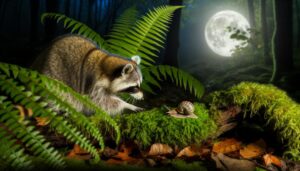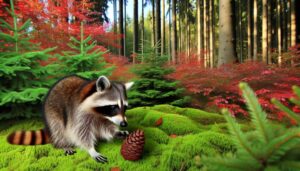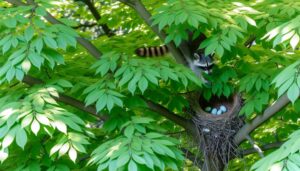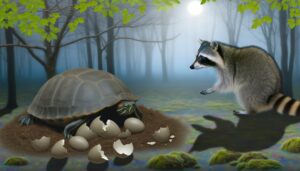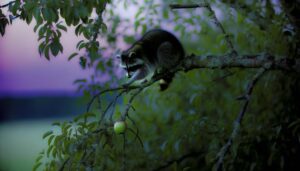Do Raccoons Eat Tree Bark?
Raccoons rarely consume tree bark due to their preference for nutrient-rich foods like fruits, nuts, insects, and small animals. Bark is not an ideal food source as it lacks essential nutrients and can lead to digestive issues.
However, in extreme conditions such as food scarcity or environmental disturbance, raccoons may resort to eating bark. This behavior is driven by survival instincts and indicates potential ecological imbalances.
Importantly, bark consumption can damage trees and affect their health. Understanding these unusual feeding behaviors can provide deeper insights into raccoon ecology and the environmental challenges they face.
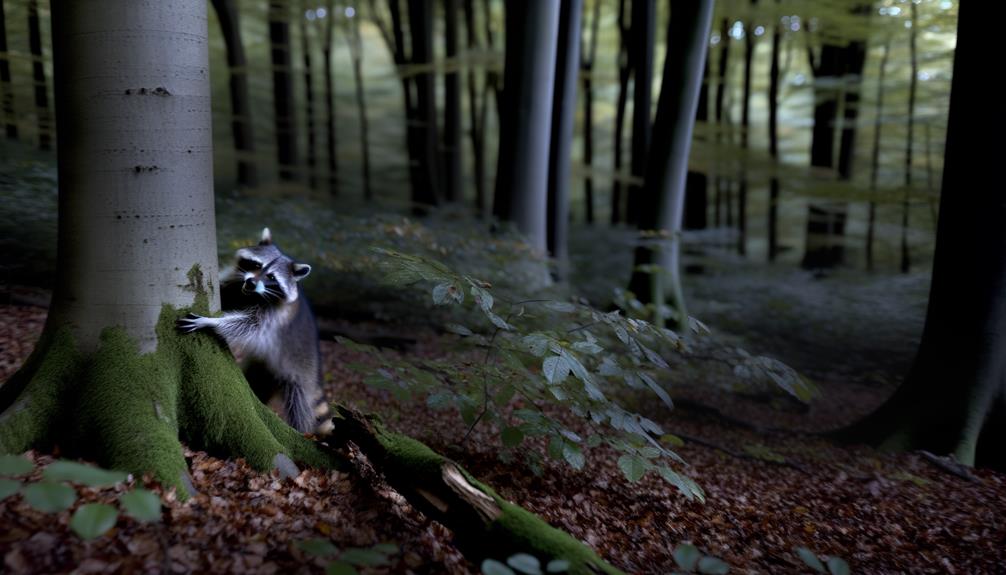
Key Takeaways
- Raccoons primarily eat fruits, nuts, insects, and small animals, not tree bark.
- Tree bark consumption by raccoons is rare and typically occurs during extreme food scarcity.
- Bark lacks essential nutrients and can lead to digestive issues in raccoons.
- Young or sick raccoons may eat tree bark due to limited food options or mobility.
- Bark consumption can indicate ecological imbalances or habitat disturbances affecting raccoon food availability.
Raccoon Dietary Overview
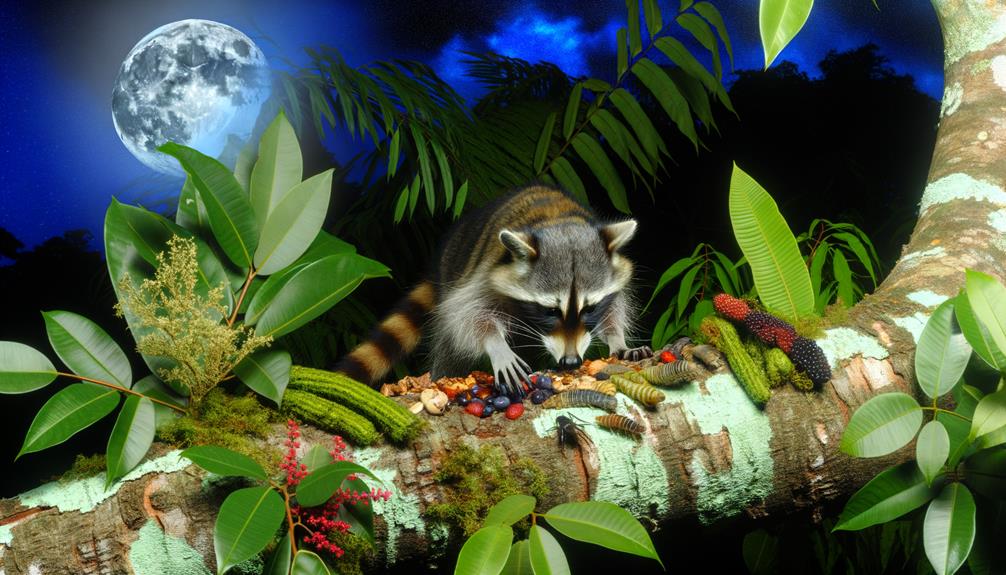
Raccoons (Procyon lotor) exhibit an omnivorous diet, consuming a wide variety of foods that include fruits, nuts, small mammals, insects, and aquatic organisms. This dietary flexibility is indicative of their opportunistic feeding behavior, allowing them to thrive in diverse environments.
Detailed observations reveal their preference for high-calorie foods, particularly during periods requiring significant energy, such as winter and breeding seasons. Raccoons are also known to scavenge human refuse, further broadening their diet.
While plant material like fruits and nuts constitutes a significant portion of their intake, animal matter provides essential proteins and fats. This varied diet underscores their adaptability and resilience, contributing to their widespread distribution across North America.
Natural Habitat and Diet
Inhabiting diverse environments ranging from forests to urban areas, raccoons adapt their diet to the available resources within their natural habitat. These omnivores exhibit a highly flexible diet that includes both plant and animal matter.
Key components of their diet can be categorized as follows:
- Fruits and Nuts: Seasonal availability determines consumption of items like berries, acorns, and other nuts.
- Invertebrates: Insects, worms, and crustaceans form a substantial part of their protein intake.
- Small Vertebrates: Amphibians, birds, and small mammals are occasionally preyed upon, providing essential nutrients.
- Human Food Waste: In urban areas, raccoons often scavenge from garbage, adapting to anthropogenic food sources.
This varied diet underscores their adaptability and ecological versatility.
Opportunistic Feeding Behavior
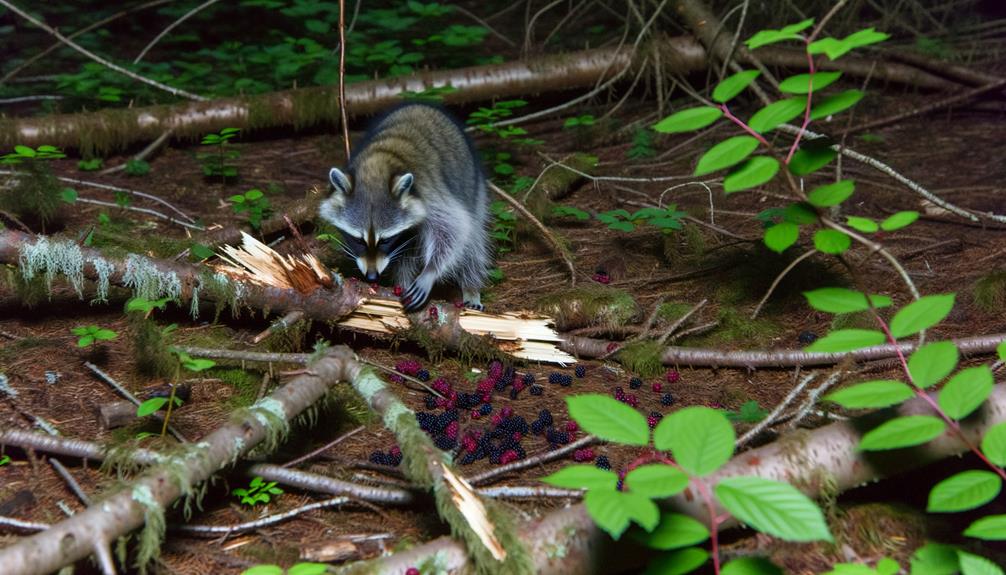
Building on their versatile diet, these nocturnal mammals display opportunistic feeding behavior that enables them to exploit a wide range of food sources. This adaptability is essential for survival, especially in urban environments where food availability can fluctuate dramatically. Their diet is not restricted to any particular type of food, allowing raccoons to consume whatever is readily available. This behavior is evident in their ability to switch between various food types based on seasonality and accessibility.
| Season | Primary Food Sources |
|---|---|
| Spring | Insects, small mammals |
| Summer | Fruits, berries |
| Fall | Nuts, seeds, agricultural crops |
| Winter | Carrion, human refuse |
This flexible feeding strategy underscores the raccoon's resilience and adaptability in diverse habitats.
Common Food Sources
Raccoons exhibit a highly adaptable diet, consuming a variety of food sources based on availability and habitat. Their common food sources include fruits and vegetables, which they often forage in both wild and urban environments, as well as small animal prey such as insects and amphibians.
Additionally, raccoons frequently exploit human food waste, making them regular visitors to garbage bins and compost heaps.
Fruits and Vegetables
A significant portion of raccoons' diet consists of fruits and vegetables, which provide essential nutrients and energy. These dietary components are vital for maintaining their health, particularly in urban and suburban environments where these animals frequently foray for food.
Observations indicate that raccoons demonstrate a preference for certain types of fruits and vegetables due to their accessibility and nutritional value. Below are common fruits and vegetables consumed by raccoons:
- Berries: Including blackberries, blueberries, and raspberries, which are rich in vitamins and antioxidants.
- Fruits: Apples, grapes, and peaches, providing both hydration and essential sugars.
- Vegetables: Corn and bell peppers, offering a good source of vitamins and minerals.
- Nuts and Seeds: Such as acorns and sunflower seeds, which supply necessary fats and proteins.
These food sources collectively support raccoons' dietary needs.
Small Animals Prey
In addition to their plant-based diet, raccoons also rely on small animals as a significant food source to meet their protein requirements. These omnivorous mammals exhibit opportunistic feeding behaviors, preying on a variety of organisms. Common small animal prey includes insects, amphibians, small mammals, and birds, as well as their eggs.
Raccoons are adept foragers, utilizing their dexterous front paws to capture these creatures effectively. They often hunt in aquatic environments, where they can find crayfish, frogs, and fish. By consuming such a diverse array of small animals, raccoons maintain a balanced diet that supports their nutritional needs.
This dietary adaptability is essential for their survival across varied habitats, ranging from urban areas to dense forests.
Human Food Waste
Human food waste constitutes a significant and readily accessible food source for raccoons, particularly in urban and suburban environments. These opportunistic feeders have adapted to exploit human refuse, which often contains a variety of high-calorie and nutrient-rich items.
Common sources of human food waste consumed by raccoons include:
- Household Garbage: Raccoons frequently rummage through residential trash bins, seeking discarded food scraps.
- Compost Piles: Improperly managed compost can attract raccoons due to the presence of decomposing organic matter.
- Pet Food: Leftover or accessible pet food provides an easy meal for raccoons.
- Restaurant Waste: Dumpsters behind restaurants often contain substantial amounts of edible waste.
These behaviors highlight raccoons' adaptability and the importance of proper waste management to mitigate human-wildlife conflicts.
Seasonal Diet Variations
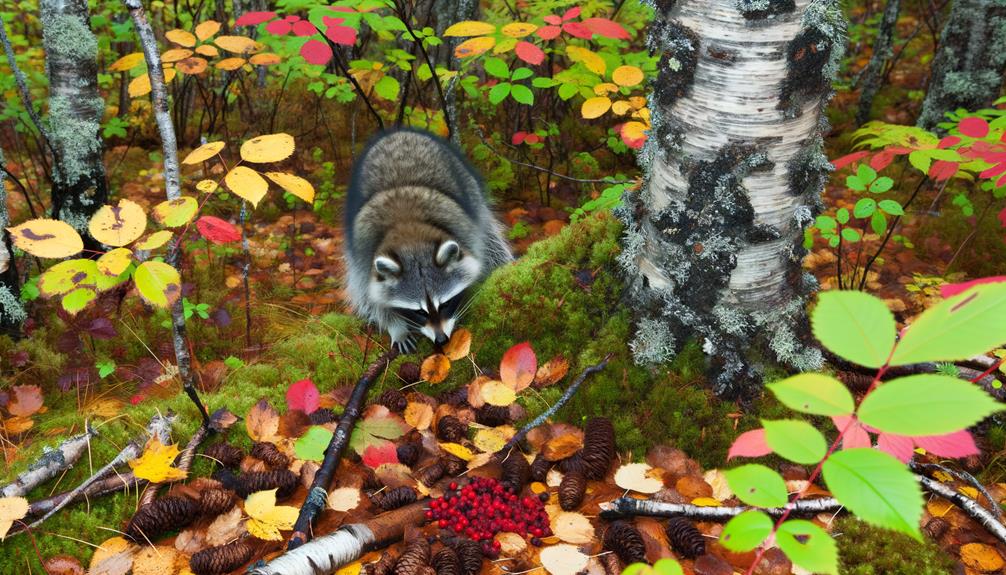
Seasonal diet variations in raccoons are influenced by the availability of different food sources throughout the year. In spring, raccoons primarily consume insects, small animals, and newly available vegetation.
Summer diets are rich in fruits, berries, and insects, reflecting the abundance of these items.
As autumn approaches, raccoons shift to consuming nuts, seeds, and acorns to accumulate fat reserves for winter.
During winter, raccoons rely heavily on stored body fat and will consume whatever food they can find, including small mammals and leftover vegetation.
These dietary shifts illustrate the raccoon's adaptability to seasonal changes in food availability, ensuring its survival through varying environmental conditions.
Such flexibility highlights the raccoon's opportunistic feeding behavior and ecological resilience.
Nutritional Needs of Raccoons
Raccoons exhibit a highly varied diet that includes fruits, nuts, insects, and small vertebrates, reflecting their omnivorous nature.
This dietary diversity guarantees that raccoons meet their essential nutritional requirements, such as proteins, fats, carbohydrates, vitamins, and minerals.
Understanding the specific nutrients raccoons derive from different food sources is vital for comprehending their overall health and ecological adaptability.
Dietary Diversity Explained
The nutritional needs of raccoons encompass a wide variety of food sources, reflecting their omnivorous diet and their adaptability to diverse environments. Their dietary diversity is essential for meeting their physiological and energetic demands.
Raccoons are known to consume:
- Fruits and Vegetables: Providing essential vitamins and fibers, these are commonly found in their natural habitat.
- Invertebrates and Small Vertebrates: Including insects and small mammals, these sources are rich in proteins and fats.
- Aquatic Organisms: Fish, amphibians, and crustaceans contribute to their intake of omega-3 fatty acids.
- Human Food Waste: In urban settings, raccoons often rely on discarded food, which can be both a blessing and a challenge for their health.
This dietary flexibility underscores their ability to thrive in a range of habitats.
Essential Nutrients Breakdown
Understanding the vital nutrients required by raccoons involves examining their intake of vitamins, minerals, proteins, fats, and carbohydrates to guarantee their overall health and survival.
Raccoons are omnivores, and their diet typically includes fruits, nuts, insects, and small animals, which provide a balanced array of nutrients. Proteins and fats are essential for energy and cellular functions, while carbohydrates supply immediate energy.
Vitamins such as A, C, and E, along with minerals like calcium and phosphorus, support metabolic processes and bone health. Additionally, raccoons require dietary fiber for digestive efficiency.
While tree bark is not a staple, it may occasionally be consumed for its trace nutrients and fiber content, contributing marginally to their dietary needs.
Tree Bark: A Food Source?

Examining the dietary habits of raccoons reveals whether tree bark constitutes a viable food source for these omnivorous mammals. Raccoons generally prefer a diverse diet including fruits, nuts, insects, and small animals. However, instances of tree bark consumption have been documented, albeit infrequently.
To understand the potential of tree bark as a food source, consider the following:
- Nutritional Content: Tree bark contains cellulose, lignin, and small quantities of minerals, but lacks essential proteins and fats.
- Digestibility: Raccoons possess simple stomachs, making the digestion of fibrous materials like bark challenging.
- Foraging Behavior: Raccoons are opportunistic feeders, often selecting more nutrient-dense and easily accessible food.
- Survival Situations: In extreme conditions with limited food availability, raccoons may resort to consuming tree bark.
This analysis underscores the limited role of tree bark in raccoon diets.
Reasons for Bark Consumption
Raccoons may consume tree bark primarily due to its nutritional benefits, including essential minerals and fibers.
Additionally, this behavior can be attributed to survival instincts, particularly during periods of food scarcity.
Understanding these reasons provides insight into raccoon foraging habits and ecological adaptability.
Nutritional Benefits
Tree bark consumption by raccoons can primarily be attributed to the nutritional benefits it provides, including essential minerals and dietary fiber. Detailed observations reveal that raccoons may choose to gnaw on tree bark for the following reasons:
- Mineral Content: Tree bark can be a source of important minerals such as calcium, potassium, and magnesium, which are essential for bodily functions.
- Dietary Fiber: The fibrous nature of bark aids in digestion and helps regulate raccoons' gastrointestinal health.
- Phytochemicals: Barks contain bioactive compounds like tannins and flavonoids, which may offer antioxidant properties.
- Energy Source: During periods of food scarcity, the carbohydrates in tree bark can provide a supplementary energy source.
These factors collectively underscore why raccoons might resort to consuming tree bark.
Survival Instincts
While nutritional benefits play a significant role, the consumption of tree bark by raccoons can also be understood through their innate survival instincts. In periods of food scarcity, raccoons exhibit opportunistic foraging behaviors, turning to unconventional food sources such as tree bark. This behavior guarantees energy intake when preferred foods are unavailable.
Additionally, during winter months, raccoons may strip bark to access the cambium layer, which provides essential nutrients. Such behavior highlights their adaptability to environmental stressors. Moreover, tree bark consumption may serve as a means of gnawing, which helps in the maintenance of dental health by naturally wearing down their continuously growing incisors.
These actions underscore raccoons' resourcefulness in securing their survival.
Observations in the Wild
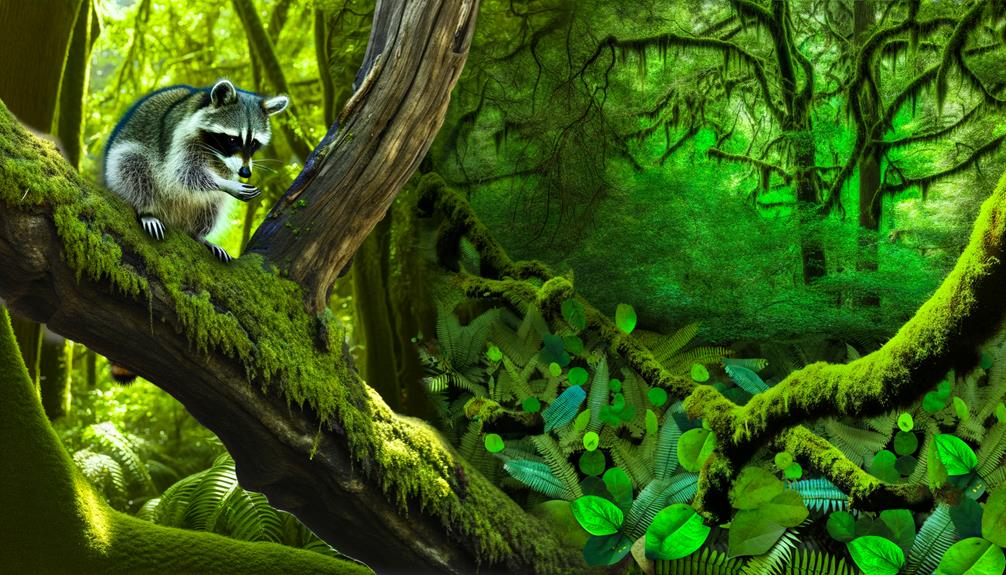
Researchers have documented a variety of foraging behaviors in raccoons, including their interactions with tree bark in their natural habitats. Detailed field observations have revealed that raccoons exhibit specific patterns when engaging with tree bark.
These behaviors include:
- Scratching and Clawing: Raccoons often scratch at tree bark, likely in search of insects or other small organisms residing within.
- Chewing and Gnawing: There are instances where raccoons gnaw on bark, potentially to access sap or other nutritional components.
- Marking Territory: Scratches and bites on bark can serve as territorial markers, indicating the presence of raccoons to other animals.
- Climbing Support: Bark provides essential support for climbing, aiding raccoons in accessing nests or escaping predators.
These behaviors underscore the multifaceted ways raccoons interact with tree bark.
Impact on Trees
Understanding the multifaceted interactions raccoons have with tree bark is essential to assess the potential impacts these behaviors may have on the health and strength of trees. Raccoons primarily strip bark to access the cambium layer, which is rich in nutrients. This stripping can lead to significant disruptions in the tree's vascular system, hindering the transport of water and nutrients.
Over time, repeated bark removal can result in weakened structural integrity, increased susceptibility to disease, and potential tree mortality. Additionally, exposed areas may invite secondary infestations by insects or fungi, further compromising tree health. These impacts underscore the importance of understanding raccoon behavior to develop effective management strategies for forest conservation.
Preventing Bark Damage
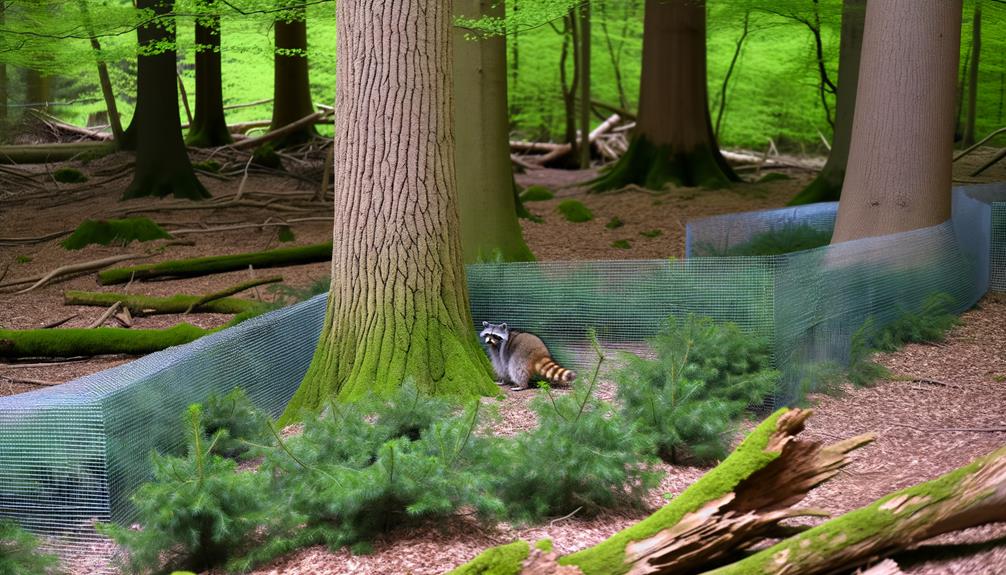
Implementing effective strategies to prevent bark damage by raccoons demands a thorough understanding of their behavior and habitat preferences. Raccoons are nocturnal and opportunistic feeders, often drawn to areas rich in food sources and shelter.
To mitigate bark damage, consider the following strategies:
- Physical Barriers:
Install metal or plastic tree guards around the base of trees to discourage raccoons from climbing.
- Habitat Modification:
Reduce access to food by securing trash bins and removing bird feeders at night.
- Repellents:
Apply commercially available raccoon repellents around tree bases. Make sure to reapply after rain.
- Trapping and Relocation:
As a last resort, use humane traps to capture and relocate raccoons, following local wildlife regulations.
These measures aim to safeguard trees by addressing the root causes of raccoon activity.
Myths and Misconceptions
Contrary to popular belief, raccoons do not typically eat tree bark as a primary food source. Their diet is remarkably diverse, consisting primarily of fruits, nuts, insects, small vertebrates, and occasionally human refuse. The misconception that raccoons consume tree bark arises from observations of their behavior, such as clawing and stripping bark, which is often associated with their foraging activities or territorial marking rather than consumption.
| Myth | Fact | Explanation |
|---|---|---|
| Raccoons eat tree bark | Raccoons do not eat tree bark | They strip bark for marking or foraging |
| Bark consumption is common | Bark consumption is rare | Their diet is primarily fruits and insects |
| Bark provides essential nutrients | Nutrients are obtained from a varied diet | Fruits, nuts, and small animals are preferred |
| Bark damage indicates eating | Bark damage often indicates marking territory | Clawing for scent-marking or insect hunting |
| Raccoons harm trees for food | Raccoons harm trees for other purposes | Primarily for non-dietary reasons |
Understanding these behaviors can aid in effective wildlife management and conservation efforts.
Conclusion
To summarize, raccoons do not typically consume tree bark as a primary food source. Their diet is highly varied and opportunistic, encompassing fruits, nuts, insects, and small animals. Although occasional bark stripping may occur, it is generally incidental and not indicative of regular feeding behavior.
Addressing concerns about potential tree damage, preventive measures can mitigate such impacts. This highlights how understanding raccoon dietary habits underscores their adaptability and the minor role bark plays in their nutritional intake.

